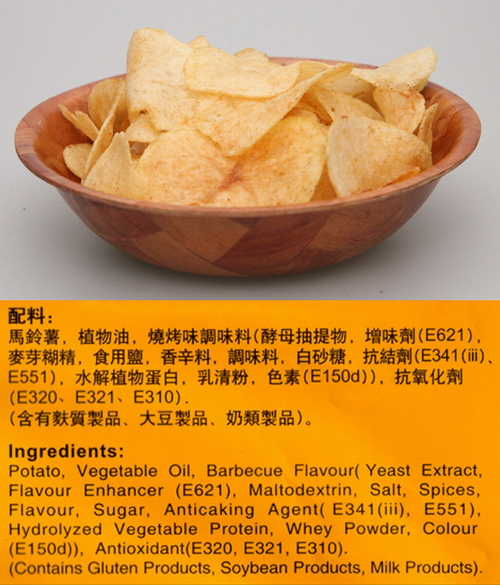
Food Safety Focus (53rd Issue, December 2010) – Food Safety Platform
The Magic of Antioxidants
Reported by Ms. Janny MA, Scientific Officer,
Risk Assessment Section, Centre for Food Safety
We all know that oxygen in air keeps us alive. Are you aware that oxygen is also a reason for our food to develop the distasteful smell, the unpleasant colour, and even a change in the texture? The chemical reaction between oxygen in air and the food substances, called oxidation, is undesirable in most foodstuffs. In this article, let's look at the magic of a group of food additives that prevents oxidation in food - antioxidants.
The Technology
In food industry, preservatives and antioxidants are often used to prolong the shelf-life of foods by protecting against deterioration. While preservatives act against microorganisms, antioxidants counter oxidation. Fats and oils, vitamins and amino acids are most often troubled by oxidation.
Fats and oils, particularly the unsaturated ones, as well as foods containing them are most likely to have oxidation problems. When the fats react with oxygen and decompose, unpleasant off-flavours and odours will be developed and cause the foods go rancid. Rancid foods may not result in food poisoning, but they have such a bad smell and taste that you may shy away from eating them. Some food manufacturers are thus using antioxidants in foods rich in fats and oils to delay the onset or slow down the development of rancidity due to oxidation. Checking the label on a pack of potato chips or a bottle of mayonnaise that you have, you may see the name or the identification number of the antioxidant together with its technological function i.e. antioxidant listed!
Vitamins and amino acids in foods are easily destroyed by oxidation and may result in discolouration and loss of nutritive value. Antioxidants are therefore also used to preserve foods rich in vitamins such as processed fruits and vegetables. In addition, you may be surprised that the seafood industry is using antioxidants to prevent black spot formation caused by amino acid oxidation in their produce such as shrimps and prawns.

Antioxidants are used in some potato chips to prevent the unpleasant off-flavours and odours
Commonly Used Antioxidants
Like other food additives, antioxidants can be natural or synthetic. Ascorbic acid (vitamin C) is naturally occurring and is the most commonly used antioxidants in food. Want to see for yourself how it works? Add a few drops of lemon juice to a piece of apple. The vitamin C in the lemon will stop the apple from browning! Vitamin C and its related substances are usually added to juice drinks, jams and sausages etc to inhibit oxidation.
Because of more effective function and at lower cost, food manufacturers are also using various man-made antioxidants, alone or in combinations, in our foods. The common synthetic antioxidants include gallates, butylated hydroxyanisole (BHA) and butylated hydroxytoluene (BHT). Meat pies, salad dressings, or any other food rich in fats or oils may contain one or more of these antioxidants to protect them from going rancid.
Regulatory Control of Antioxidants
In Hong Kong, the use of antioxidants is regulated under the Preservatives in Food Regulation, which has recently been amended and came into effect on 1 July 2010. Together with the five newly permitted antioxidants (i.e. guaiac resin, isopropyl citrates, stannous chloride, tertiary butylhydroquinone (TBHQ) and thiodipropionates), a total of 13 antioxidants are permitted in various foods in Hong Kong.


